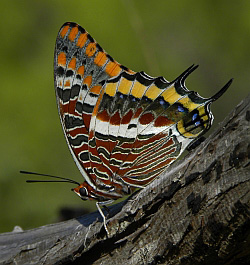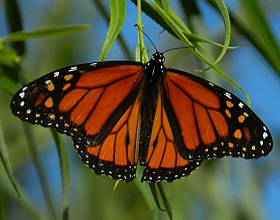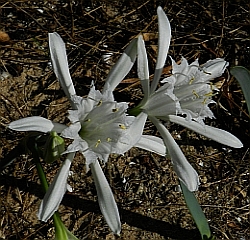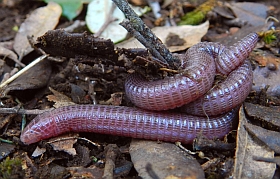A visit to south-west Spain in the autumn offers the travelling naturalist a unique opportunity for wildlife watching and photography, particularly of the 'macro' variety. Although perhaps best know among birdwatchers for the autumn migration across the Strait of Gibraltar, The magnificent Two-tailed Pasha is undoubtedly the showiest of the butterflies on offer, and we should encounter obliging adults in several localities – especially if we take along a ripe banana or two! – along with other 'giants' such as Swallowtail, Scarce Swallowtail, Monarch and Plain Tiger. Among the smaller butterflies we should keep an eye out for African Grass, Long-tailed and Lang's Short-tailed Blues, Geranium Bronze, Spanish Brown Argus, Bath White and Mallow Skipper, with Striped and Tree Graylings and The Hermit possible among the satyrids (browns). 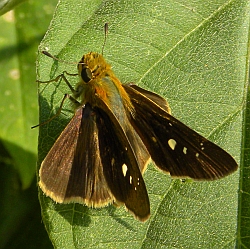 Zeller's Skipper Borbo borbonica© Teresa Farino Zeller's Skipper Borbo borbonica© Teresa Farino
Perhaps the most sought-after butterfly of the trip for many, however, will be Zeller's Skipper. Known only from southern Iberia in Europe, this large, fast-flying skipper is something of a 'Holy Grail' for butterfly lovers. Despite its relative scarcity in Spain, over the past few years I have located no less than five separate colonies of Zeller's Skipper in this part of Cádiz, so we'll definitely be in with a good chance of finding this enigmatic butterfly again in 2017. It usually flies together with the superficially rather similar, albeit smaller, Mediterranean Skipper. Nocturnal lepidoptera of note might include Mediterranean Tiger, Grass Eggar, Grass Processionary, the dinky little Codet's Shield Moth and chunky hawkmoths such as Spurge, Silver-striped and Convolvulus, with the striking noctuid Grammodes bifasciata, Crimson Speckled Moth, The Vestal, Grass Viridian, Tamarisk Heath and Hummingbird Hawkmoth abundant during the day. Among the noctuids likely to come to light are Porter's Rustic, The Sorcerer, Thalpophila vitalba and Small Wainscot, with geometers including Scalloped Barred, Light Magpie and Lefebvre's Bloom. 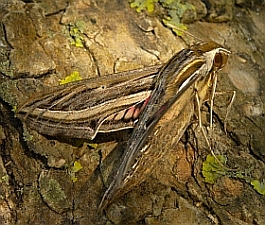 Silver-striped Hawkmoth Hippotion celerio© Teresa Farino Silver-striped Hawkmoth Hippotion celerio© Teresa Farino
Dragonflies also provide one of the principal focal points of the tour. Given favourable conditions (i.e. waterbodies, streams and rivers with plenty of water), we should locate characteristic species of the season such as Blue and Lesser Emperors, Migrant and Southern Hawkers, Epaulet and Keeled Skimmers, Common and Red-veined Darters, Broad Scarlet and – one of my favourites – the showy Violet Dropwing. A respectable assortment of damselflies should include Copper Demoiselle, Small and Western Willow Spreadwings, Iberian Bluetail, Small Red-eye and Blue-eye, and there's also a chance of coming across the enigmatic Dark Spreadwing in the coastal saltmarshes. Also on offer at this time of year are essentially African species with just a toe-hold in Europe, namely Faded Pincertail, Green Hooktail, Long Skimmer, Desert Darter, Northern Banded Groundling (Brachythemis impartita), Black Percher and Orange-veined Dropwing, the latter a recent coloniser of Spain from northern Africa. 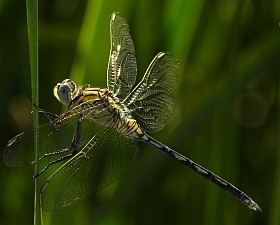 Female Long Skimmer Orthetrum trinacria© Teresa Farino Female Long Skimmer Orthetrum trinacria© Teresa Farino
Other invertebrates of note typically found in autumn in Cádiz are Two-spotted Cricket, Desert Locust, Egyptian Grasshopper, the gigantic Brown-headed Grasshopper (Acanthacris ruficornis citrina), Southern Sickle-bearing Bush-cricket and Lily Bush-cricket, as well as the gloriously marked Mediterranean Mantis, the diminutive Dwarf European mantis and the huge and rather intimidating Giant African Mantis. We'll also be looking out for a number of charismatic beetles, including the rhinoceros beetle Phyllognathus excavatus, the stunning – but introduced and immensely destructive – Palm Weevil, and the massive-jawed carabid Scarites cyclops, a two-inch long, fearsome predator of coastal sands. 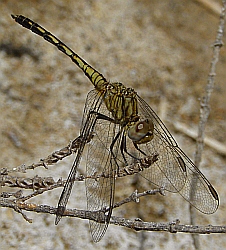 Black Percher Diplacodes lefebvrii© Teresa Farino Black Percher Diplacodes lefebvrii© Teresa Farino
Despite bordering the Atlantic shores, the flora of this part of Cádiz is essentially Mediterranean in character. Broad swathes of Stone Pines can be found near Barbate, with an understorey of Prickly Juniper, Holly Oak, Wild Olive, Lentisc, Strawberry-tree (larval host plant of the Two-tailed Pasha), Rosemary, French Lavender and Dwarf Fan-palm. Clumps of autumn-flowering bulbs – Sea Squill, Autumn Snowflake and Autumn Lady's-tresses – brighten the forest floor. 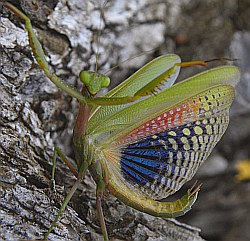 Mediterranean Mantis Iris oratoria© Teresa Farino Mediterranean Mantis Iris oratoria© Teresa Farino
Coastal sand-dunes will be studded with the huge white trumpets of Sea Daffodils at this time of year, while field margins inland are decorated with rosettes of white- or mauve-flowered Mandrakes, Autumn Squill, the Iberian autumn crocus Colchicum lusitanum, Autumn Narcissus and the delicate yellow Tapeinanthus (Narcissus humilis). Warm days bring out many of the typical reptiles of the region, including Spanish Terrapin, Spiny-footed, Ocellated and Vaucher's Wall Lizards, Large Psammodromus and Iberian Three-toed Skink, The volume of migrant birds that floods into the region as a prelude to crossing the Strait of Gibraltar en route to their wintering quarters in sub-Saharan Africa is nothing short of incredible. Whilst waiting for perfect weather conditions to make the crossing, huge numbers of Short-toed and Booted Eagles, Black Kites, Honey Buzzards and Black Storks, At this time of year, western Andalucía's coastal wetlands, shallow inland lagoons and rice paddies are literally heaving with waterbirds, notably huge numbers of White Storks plus Glossy Ibis, Purple Gallinules, Yellow Wagtails and waders galore, with Marsh Harrier, Hobby and Black-winged Kite among the most typical raptors. Although birds are not the principle focus of this tour, we'll definitely be impressed this super-abundance of avian life, which comes in all shapes and sizes. 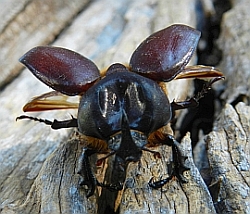 Rhinoceros Beetle Phyllognathus excavatus
© Teresa Farino
Rhinoceros Beetle Phyllognathus excavatus
© Teresa Farino
Autumn in AndalucíaLeaders: Teresa Farino, in collaboration with Sue Eatock 2018 Dates: Tues. 9 October – Weds. 17 October Price: 1,670€, including half-board, en suite accommodation at the comfortable, family-run Cortijo de los Monteros and Casa de las Piedras, picnic lunches, hired minibus transport throughout, all entry fees and the services of the leaders. A single-room supplement of 170€ is applicable. Although the cost of the tour is given in euros, clients may pay in sterling, the exchange rate to be calculated at the time of payment using www.oanda.com This is a land-based tour. Flights and travel insurance (obligatory) are the responsibility of the client. Pick-up details: For this tour, clients will be booking their flights independently. Given that Málaga is almost three hours’ drive from Benalup and Grazalema, we have decided that the best option is to start from – and return to – Seville, which is only about an hour and a half from our bases. Several airlines fly direct to this destination from a range of UK airports. In order to give us time for a comfortable journey to the hotel in time for dinner, please choose a flight that arrives in Seville by 15.00 on Tuesday 9 October 2018. For the return journey at the end of the tour, we are unlikely to get to the airport before about 12.00 on Wednesday 17 October 2018, so you will need to select a flight that departs after 14.00. Of course, the earlier and later your flights, respectively, the more opportunity we will have to visit interesting habitats en route. 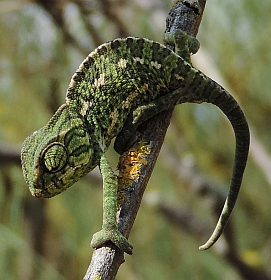 Mediterranean Chameleon Mediterranean ChameleonChamaeleo chamaeleon© Teresa Farino Please contact Teresa to discuss flight times and pick-up arrangements further if you have any queries, as the itinerary is flexible, up to a point, and it may even be possible to accommodate flights to Jerez, which is even closer. Alternatively, those wishing to travel to Cádiz independently can arrange to meet the group at the Cortijo de los Monteros on the first evening. Group size: maximum 8 clients. Booking information: please contact Teresa Farino for further details and a booking form, or if you have any queries about this tour.
|
|
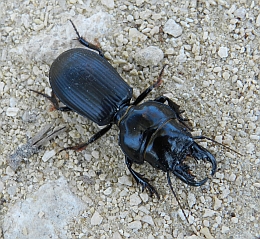 Scarites cyclops© Teresa Farino Scarites cyclops© Teresa Farino
Other natural history tours in Andalucía:Wildlife of AlmeríaThe Sierra de Grazalema Related information:Sierra de GrazalemaRead about Teresa Farino Wildlife holidays and natural history tours in Spain & Portugal |
||||||||||||||||||||||||||||||||
|
||||||||||||||||||||||||||||||||||


